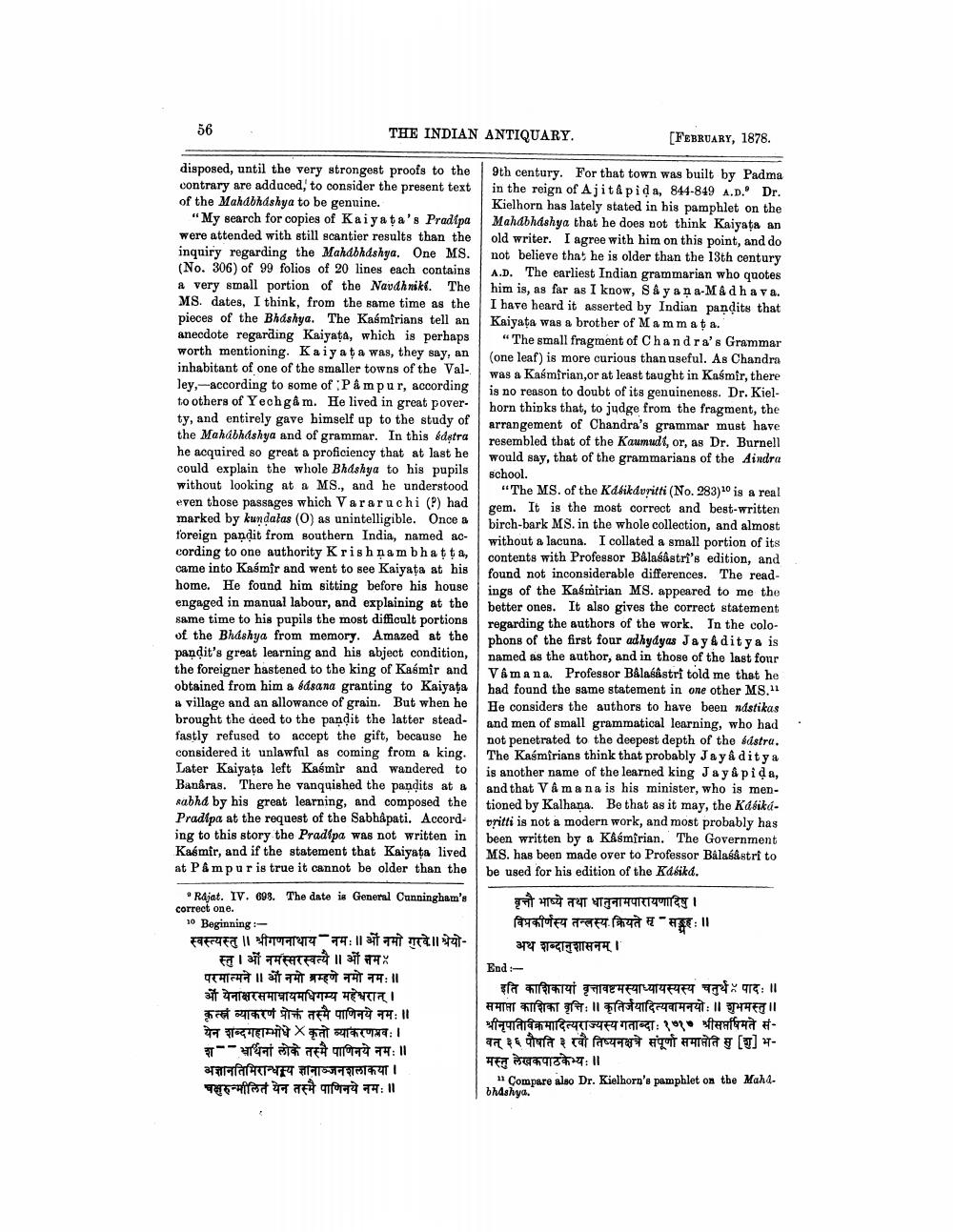________________
THE INDIAN ANTIQUARY.
[FEBRUARY, 1878.
disposed, until the very strongest proofs to the 9th century. For that town was built by Padma contrary are adduced, to consider the present text in the reign of Ajit&pida, 844-849 A.D. Dr. of the Mahabhashya to be genuine.
Kielhorn has lately stated in his pamphlet on the "My search for copies of Kaiya ta's Pradipa Mahabhashya that he does not think Kaiyata an were attended with still scantier results than the old writer. I agree with him on this point, and do inquiry regarding the Mahabhdshya. One MS. not believe tha) he is older than the 13th century (No. 306) of 99 folios of 20 lines each contains A.D. The earliest Indian grammarian who quotes a very small portion of the Navdhniki. The him is, as far as I know, Sayan a-Madhava. MS. dates, I think, from the same time as the I have heard it asserted by Indian pandits that pieces of the Bhashya. The Kasmirians tell an Kaiyata was a brother of Mammaţa. anecdote regarding Kaiyata, which is perhaps 1 "The small fragment of Chandra's Grammar worth mentioning. Kaiyaţa was, they say, an (one leaf) is more curious than useful. As Chandra inhabitant of one of the smaller towns of the Val
was a Kasmirian,or at least taught in Kasmir, there ley-according to some of Pâmpur, according is no reason to doubt of its genuineness. Dr. Kielto others of Yechgâm. He lived in great pover
horn thinks that, to judge from the fragment, the ty, and entirely gave himself up to the study of
arrangement of Chandra's grammar must have the Mahabhdshya and of grammar. In this editra
resembled that of the Kaumudt, or, as Dr. Burnell he acquired so great a proficiency that at last he would say, that of the grammarians of the Aindra could explain the whole Bhashya to his pupils
school. without looking at a MS., and he understood "The MS. of the Kdfikdvritti (No. 283)20 is a real even those passages which Vararuchi (P) had
gem. It is the most correct and best-written marked by kundalas (O) as unintelligible. Once a birch-bark MS. in the whole collection, and almost foreign pandit from southern India, named ac- without a lacuna. I collated a small portion of its cording to one authority Krishnambhatta,
contents with Professor Balasastri's edition, and came into Kasmir and went to see Kaiyata at his found not inconsiderable differences. The read home. He found him sitting before his house ings of the Kasmirian MS. appeared to me the engaged in manual labour, and explaining at the
better ones. It also gives the correct statement same time to his pupils the most difficult portions regarding the authors of the work. In the coloof the Bhashya from memory. Amazed at the
phons of the first four adhydyas Jay &ditya is pandit's great learning and his abject condition,
named as the author, and in those of the last four the foreigner hastened to the king of Kasmir and Vamana. Professor Balasastri told me that he obtained from him a 6dsana granting to Kaiyata had found the same statement in one other MS.11 a village and an allowance of grain. But when he
He considers the authors to have been ndstikas brought the deed to the pandit the latter stead- and men of small grammatical learning, who had fastly refused to accept the gift, because he not penetrated to the deepest depth of the adstru. considered it unlawful as coming from a king. The Kasmirians think that probably Jayaditya Later Kaiyata left Kaśmir and wandered to is another name of the learned king Jay&pida, Banaras. There he vanquished the pandits at al and that V âmana is his minister, who is menrabhd by his great learning, and composed the tioned by Kalhana. Be that as it may, the KibikáPradipa at the request of the Sabhåpati. Accord vritti is not a modern work, and most probably has ing to this story the Pradipa was not written in been written by a Kasmirian. The Government Kasmir, and if the statement that Kaiyata lived MS. has been made over to Professor Balabastri to at P&mpur is true it cannot be older than the
be used for his edition of the Katiká. Rajat. IV. 699. The date is General Canningham's
वृत्तौ भाष्ये तथा धातुनामपारायणादिषु । correct one. 10 Beginning :
विप्रकीर्णस्य तन्तस्य क्रियते म सङ्कहः ।। FUET 11 2 79:at Hall
अथ शब्दानुशासनम्। स्त । ओं नमस्सरस्वत्यै ॥ओं नम:।
End :परमात्मने । औं नमो ब्रम्हणे नमो नमः॥ ओं येनाक्षरसमानायमधिगम्य महेश्वरान् ।
इति काशिकायां वृत्तावष्टमस्याध्यायस्यस्य चतुर्थ पादः ॥
समाता काशिका वृत्तिः ॥ कृतिर्जयादित्यवामनयोः ॥ शुभमस्तु ।। कृत्स्नं व्याकरणं प्रोक्तं तस्मै पाणिनये नमः॥
श्रीनृपतिविक्रमादित्यराज्यस्य गताब्दा: ११. श्रीसप्तर्षिमते संयेन शब्दमहाम्भोधेकृतो व्याकरणप्रवः।
# 1 at 7
T :11
heatrit
far riquesa y (u) -
मस्तु लेखकपाठकेभ्यः॥ अज्ञानतिमिरान्धस्य ज्ञानाञ्जनशलाकया। चक्षरुन्मीलितं येन तस्मै पाणिनये नमः॥
Compare also Dr. Kielborn's pamphlet on the Mahabhashya.




